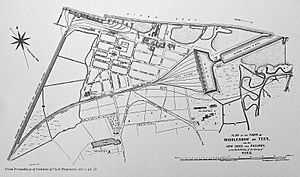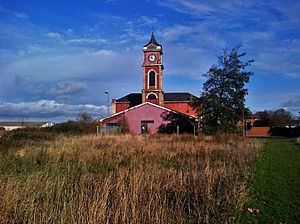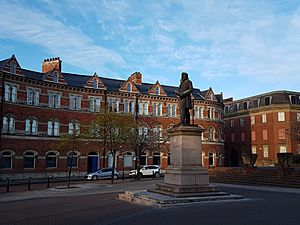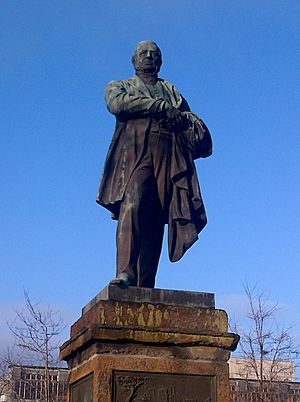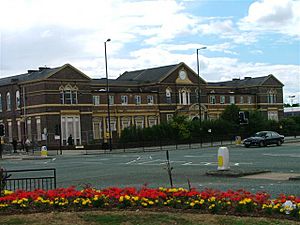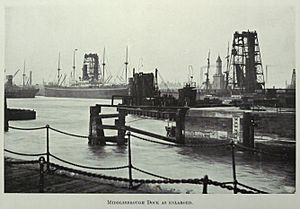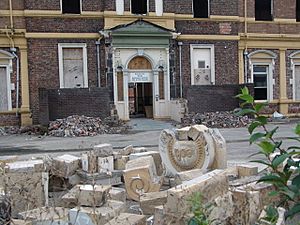History of Middlesbrough facts for kids
Middlesbrough started a long time ago as a small religious place called a Benedictine priory. It was built on the south bank of the River Tees. Its name might come from being in the middle of two important holy places: Durham and Whitby. The oldest way Middlesbrough's name was written was "Mydilsburgh," which includes the old word "burgh" meaning a fortified town or settlement.
Contents
Early History of Middlesbrough
Monks and Vikings
Around the year 686, a small group of monks started a religious cell in Middlesbrough. This was set up by St. Cuthbert because St. Hilda, who was in charge of Whitby Abbey, asked him to. The land around Middlesbrough belonged to Whitby Abbey and another priory called Guisborough. In 1119, a powerful lord named Robert Bruce gave the church of St. Hilda in Middleburg to Whitby Abbey. This church was looked after by 12 Benedictine monks until King Henry VIII closed it down in 1537 during the Dissolution of the Monasteries.
After the Anglo-Saxons lived here, Viking settlers arrived. You can still see their influence in many local place names. For example, names ending in "by" (which means village in Danish) like Ormesby, Stainsby, and Tollesby were once separate villages. These villages were named after Vikings like Orm, Steinn, and Toll. Other nearby places like Maltby (from Malti), Ingleby Barwick, and Thornaby (from Thormod) also have Viking roots.
Some old settlements, like the medieval village of Stainsby, are now just grassy mounds near the A19 road. People left Stainsby by 1757, but its name lives on in local schools and road names.
Middlesbrough's Growth: Coal and Docks
In 1801, Middlesbrough was tiny, just a farm with only 25 people. But in the mid-1800s, it grew incredibly fast! In 1828, a very important Quaker banker and coal mine owner named Joseph Pease sailed up the River Tees. He was looking for a good spot to build new coal docks.
In 1829, Joseph Pease and other Quaker businessmen bought the Middlesbrough farm and about 527 acres of land. They started a company called the Middlesbrough Estate Company. They planned a new coal port, designed by John Harris, on the south bank of the Tees. The first coal docks, called "Port Darlington," were built. A new village grew up next to the port to house the workers, taking the name Middlesbrough from the old farm.
This small farm turned into a village with streets like North Street, South Street, and Commercial Street, all laid out in a grid pattern around a market square. The first house was built in 1830. Many new businesses opened, including shops, inns, and workshops for builders and blacksmiths.
The port was connected to the Stockton and Darlington Railway (S&DR) in December 1830. This link helped Middlesbrough become very important for shipping coal. The port became so busy that a bigger dock was needed. In 1839, work began on the Middlesbrough Dock, designed by Sir William Cubitt and built by George Turnbull. It cost a lot of money, about £122,000 (which is like £9.65 million today!). The dock officially opened on May 12, 1842, and the S&DR bought it.
Ironopolis: The Iron and Steel Era
Iron and steel became super important in the Tees area starting in 1841. That's when Henry Bolckow and John Vaughan started their iron factory, the Vulcan iron foundry. John Vaughan was very skilled and found a huge amount of Ironstone in the nearby Eston Hills in 1850. He also brought in new ways of working with blast furnaces. Because of these things, their company, Bolckow, Vaughan & Co., Ltd, became incredibly successful and one of the biggest companies around. Teesside became known as the "Iron-smelting centre of the world."
By 1851, Middlesbrough's population had exploded from just 40 people in 1829 to 7,600! The amount of Pig iron produced grew ten times bigger between 1851 and 1856. By the mid-1870s, Middlesbrough was making one-third of all the pig iron in the entire country! This is why Middlesbrough earned the nickname "Ironopolis."
On January 21, 1853, Middlesbrough was given a Royal Charter of Incorporation. This meant the town could have its own mayor, aldermen, and councillors. Henry Bolckow became the first mayor in 1853.
Welsh and Irish Communities
Welsh Migration to Middlesbrough
A community of Welsh people settled in Middlesbrough even before the 1840s, mostly working in mining. Many important leaders in the town's business, politics, and culture came from this group:
- John Vaughan started Teesside's first ironworks in Middlesbrough in 1841. He had learned a lot about the iron industry in South Wales and encouraged hundreds of skilled Welsh workers to come to Teesside.
- Edward Williams (iron-master) started as a clerk but became an ironmaster, a local politician, and even Mayor of Middlesbrough. His sons, Aneurin and Penry, later became Members of Parliament for the area.
- E.T. John came from Wales as a junior clerk and became a director of several industrial companies and a politician.
- Windsor Richards was an engineer who helped the town switch from making iron to making steel.
Most Welsh people who moved to Middlesbrough came from the iron and coal areas of South Wales. By 1861, 42% of the town's ironworkers were Welsh, and one in twenty of the total population was Welsh. There were even places named "Welch Cottages" and "Welch Place" near the Vulcan works. Middlesbrough became a hub for Welsh communities in other nearby towns too.
Cultural Impact of Welsh Settlers
A Welsh Baptist church was active in Middlesbrough by 1858, and St Hilda's Anglican church even offered services in the Welsh language. Churches and chapels were central to Welsh culture. They supported choirs, Sunday Schools, social groups, and educational meetings. By the 1870s, many more Welsh chapels were built, and the first Eisteddfodau (Welsh cultural festivals) were held.
By the 1880s, Welsh culture was thriving. The Eisteddfodau attracted people from outside the Welsh communities. In 1890, the Middlesbrough Town Hall hosted the first Cleveland and Durham Eisteddfod. This event was special because it welcomed everyone, including Irish Catholic choirs and the bishop of the new Roman Catholic Diocese of Middlesbrough.
In the early 1900s, this Eisteddfod became the biggest yearly event in Middlesbrough and the largest Eisteddfod outside Wales. It greatly influenced the town's culture, especially its music. By 1911, the Eisteddfod had 22 types of musical competitions. A strong tradition of choirs continued in Middlesbrough long after the Eisteddfod and chapels were gone.
Irish Migration to Middlesbrough
From 1861 to 1871, Middlesbrough had the second-highest percentage of Irish-born residents in England, after Liverpool. In 1861, Irish people made up 15.6% of Middlesbrough's population. Even though this dropped to 9.2% in 1871, Middlesbrough still had the second-largest Irish population in England.
The town's fast growth and industries needed many workers for the blast furnaces and steel works. This attracted many people from Ireland who needed jobs. Besides Irish people, Scottish, Welsh, and other international residents made up 16% of Middlesbrough's population in 1871. Another wave of Irish migration happened in the early 1900s when Middlesbrough's steel industry was booming. This continued until the 1950s. Today, fewer Irish-born residents live in Middlesbrough, but many families still have strong Irish heritage.
Middlesbrough's Industrial Peak and World War II
Middlesbrough kept growing rapidly in the second half of the 1800s, thanks to its iron and steel industries. In 1864, the North Riding Infirmary (a hospital) opened.
In 1867, Middlesbrough became a new parliamentary borough, meaning it could elect its own Member of Parliament. Henry Bolckow was elected the first MP the next year. In 1875, Bolckow, Vaughan & Co opened the Cleveland Steelworks, starting the town's move from making iron to making steel. By 1900, Bolckow, Vaughan & Co was the biggest steel producer in Great Britain and possibly one of the largest in the world.
By the early 1900s, Middlesbrough's population reached 90,000. In 1914, Dorman Long, another big steel company from Middlesbrough, became the largest company in Britain. They employed over 20,000 people. Dorman Long even built the steel parts for the famous Sydney Harbour Bridge in Australia (1932) and the Tyne Bridge in Newcastle.
Several large shipyards also operated along the River Tees, building many ships.
World War II Bombings
Middlesbrough was the first major British town and industrial target to be bombed during the Second World War. On May 25, 1940, a German bomber dropped 13 bombs, one of which made a large hole in the South Bank football ground. RAF fighter planes chased the bomber away. Two months later, Prime Minister Winston Churchill visited the town to see the people and check the defenses.
German bombers often flew over the Eston Hills on their way to targets further inland. On March 30, 1941, a German Junkers Ju 88 plane was shot down by two Spitfires over Middlesbrough. The plane crashed into the ground and was mostly buried.
On December 5, 1941, a Spitfire crashed near Eston Hills due to bad weather. On January 15, 1942, a German Dornier Do 217 plane was hit by gunfire from a ship and then crashed into a barrage balloon cable over the River Tees. The burning bomber fell onto railway tracks, making a deep hole. In 1997, parts of this plane were found and displayed in a museum.
Railway Station Bombing
On August 4, 1942, a German Dornier Do 217 bomber dropped bombs on the Middlesbrough railway station. One bomb badly damaged the station's glass and steel roof. A train in the station was also damaged, but luckily, no passengers were on board. Eight people were killed, and the station was closed for two weeks.
The Green Howards Regiment
The Green Howards was a British Army infantry regiment that had a very strong connection to Middlesbrough and the area south of the River Tees. This regiment was formed a long time ago in 1688. As Middlesbrough grew, many men from the town joined the Green Howards. In 2006, this famous regiment joined with others to form the new Yorkshire Regiment. They are now known as 2 Yorks, The 2nd Battalion The Yorkshire Regiment (Green Howards).
Middlesbrough After World War II
By the end of World War II, over 200 buildings in Middlesbrough had been destroyed. The town lost 99 civilians because of enemy attacks.
After the war, many old Victorian houses were pulled down, and central Middlesbrough was rebuilt. Heavy industries were moved to new areas better suited for modern technology. Middlesbrough started to look very different.
The town's old Gaumont cinema, which was an opera house until the 1930s, was demolished in 1971. The Cleveland Centre shopping mall opened in the same year. In 1974, Middlesbrough became part of a new county called Cleveland.
In the 1980s, the A66 road was built through the town. This meant that Middlesbrough's Royal Exchange building and a multi-storey hotel called the Star and Garter Hotel had to be demolished to make way for the road. The Victorian-era North Riding Infirmary hospital was taken down in 2006 and replaced by a hotel and a supermarket.
More shopping centers opened: Hill Street in 1981 and Captain Cook Square in 1999.
Middlesbrough F.C.'s modern Riverside Stadium opened on August 26, 1995, next to Middlesbrough Dock. The football club moved there from Ayresome Park, which had been their home for 92 years.
When Cleveland County was abolished in 1996, Middlesbrough became part of North Yorkshire again.
The original St. Hilda's area of Middlesbrough, which had declined over many years, was renamed Middlehaven in 1986. This was part of plans to build new things there. Middlehaven now has new buildings like Middlesbrough College and Middlesbrough FC's Riverside Stadium. There's also the "Boho" zone, which offers office space for businesses, and "Bohouse" for housing. Some of the original street names from the town's first grid-like plan still exist in this area today.
Middlesbrough continued to expand outwards throughout the 1900s, taking in nearby villages like Linthorpe, Acklam, Ormesby, Marton, and Nunthorpe. This expansion continues even today.
Images for kids


